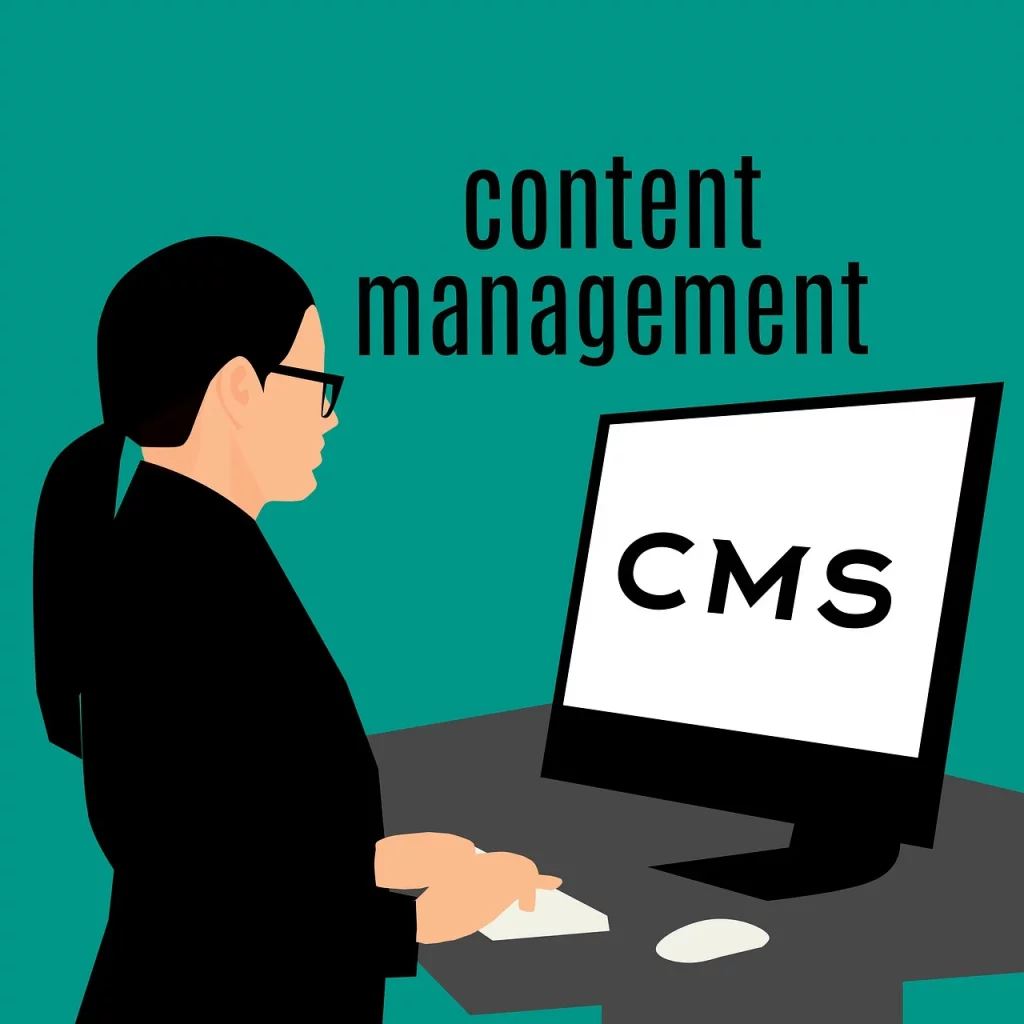Whether you are embarking on your content marketing journey or have been following the same path for some time, there is timeless wisdom in revisiting your content strategy. Ensuring that it remains current, innovative, and engaging for your prospects and customers is a strategic imperative. After all, your audience’s buying intentions can evolve at any time, and it’s crucial to be ready to meet their needs, no matter when or how they decide to make a purchase.

Steps for Content Marketing:
A. Step 1 of Content Marketing Strategy: Defining Your Goal

- Purpose: At the heart of your content marketing strategy lies a clear and compelling goal. This goal should address the “why” behind your content efforts. In our example, imagine you are the marketing manager at a tech startup.
- Real-Life Example: Your primary objective is to increase brand visibility and generate leads in the highly competitive tech industry. You need to define this goal explicitly because it will drive all your content creation and marketing efforts.
- Tool in Action:
To validate the need for your content marketing plan, it’s essential to conduct a thorough analysis of your current online presence and your competitors’ strategies. This analysis will help you identify gaps and opportunities in your content strategy and ensure that your efforts are aligned with your business goals. Two powerful tools that can assist you in this process are Google Analytics and SEMrush.
- Google Analytics: Google Analytics is a robust web analytics platform that provides a wealth of information about your website’s performance and user behavior. Here’s how you can use it to validate your content marketing plan:
- Traffic Analysis: Start by examining your website’s traffic data. Look at metrics such as the number of visitors, pageviews, and bounce rate. This will give you an understanding of your website’s overall performance.
- Content Performance: Dive deeper into your content performance by analyzing which pages and blog posts receive the most traffic. Identify which topics resonate most with your audience and which need improvement.
- Conversion Tracking: Use conversion tracking to measure how well your content is driving desired actions on your site, such as form submissions, downloads, or purchases. This can help you determine the ROI of your content marketing efforts.
- Audience Insights: Explore the demographics and interests of your website visitors. This data can help you tailor your content to better meet the needs and preferences of your target audience.
- Acquisition Channels: Understand where your website traffic is coming from, whether it’s through organic search, social media, referral sites, or paid advertising. This insight can inform your content distribution strategy.
2. Semrush: SEMrush is a comprehensive SEO and competitive analysis tool that can provide valuable insights into your competitors’ strategies. Here’s how you can use it to validate your content marketing plan:
- Competitor Research: Start by identifying your main competitors in the online space. SEMrush allows you to enter their domains and discover a wealth of information about their digital marketing efforts.
- Keyword Research: SEMrush provides data on the keywords your competitors are ranking for. You can identify which keywords are driving the most traffic to their websites and assess whether you should target similar keywords in your content.
- Backlink Analysis: Analyze your competitors’ backlink profiles to discover which websites are linking to their content. This can help you identify potential link-building opportunities for your own content.
- Content Gap Analysis: SEMrush’s content gap tool allows you to compare your content to that of your competitors. You can identify topics and keywords that your competitors are ranking for but you are not, helping you fill content gaps.
- Content Performance: Track the performance of your competitors’ content, including social shares and estimated organic traffic. This can give you an idea of which types of content are resonating with their audience.
2. Organizing Goals by Priority:
- Priority Ranking: Not all goals are created equal. Some are more critical than others. It’s essential to rank your goals based on their urgency and importance.
- Real-Life Example: In our tech startup scenario, you might determine that improving your website’s search engine optimization (SEO) and creating engaging blog content are top priorities. These align closely with your overarching goal of increasing brand visibility and generating leads.
- Tool in Action:
Managing and organizing your goals effectively is crucial for achieving success. Project management tools like Trello and Asana offer powerful features that can help you streamline your workflow and keep your projects on track.
- Trello:
Trello is a user-friendly project management tool that uses a visual approach to task management. Here’s how you can utilize Trello for managing and organizing your goals:
- Boards: Create boards for different projects or goals you want to manage. Each board acts as a workspace for organizing tasks and information.
- Lists: Within each board, you can create lists to represent different stages or categories of tasks. For example, you might have lists like “To-Do,” “In Progress,” and “Completed.”
- Cards: Tasks are represented as cards within lists. You can add details to each card, including descriptions, due dates, attachments, and checklists.
- Labels: Use labels to categorize tasks by priority, type, or any other relevant criteria. This helps you quickly identify and filter tasks.
- Assign Members: Assign team members to specific tasks by adding them as card members. This clarifies responsibilities and promotes collaboration.
- Due Dates: Set due dates for tasks to ensure that everything stays on schedule. Trello sends notifications to remind team members of upcoming deadlines.
- Drag-and-Drop: Easily move cards between lists to update their status. For example, when a task moves from “In Progress” to “Completed,” you can simply drag and drop it.
- Comments: Foster communication within tasks by leaving comments. This allows team members to discuss progress or ask questions directly on the card.
- Attachments: Attach relevant files or documents to cards to keep all necessary information in one place.
2. Asana: Asana is another robust project management tool that offers a wide range of features for goal organization:
- Projects: Create projects to represent your goals or initiatives. Within each project, you can add tasks and subtasks.
- Tasks: Break down your goals into individual tasks. Each task can have its own description, due date, and assigned team member.
- Sections: Organize tasks within projects using sections. Sections act as containers for related tasks, making it easy to group and prioritize them.
- Assignees: Assign team members to tasks, so everyone knows who’s responsible for what.
- Due Dates: Set due dates for tasks to establish timelines and keep your projects on schedule.
- Dependencies: Create task dependencies to ensure that one task can’t be completed until another is finished.
- Comments: Encourage collaboration by leaving comments on tasks. Team members can discuss progress and provide updates.
- Attachments: Attach files and links to tasks to provide additional context or resources.
- Calendar View: View your tasks and deadlines in a calendar format to get a visual overview of your schedule.
3. Using the SMART Framework to Define Goals:
- SMART Goal: SMART stands for Specific, Measurable, Achievable, Relevant, and Time-bound. It’s a framework that helps you transform broad goals into actionable and trackable objectives.
- Real-Life Example: Building on your goal to increase brand visibility and generate leads, you could create a SMART goal such as, “Increase website traffic by 30% within six months through a combination of SEO optimization and publishing weekly blog posts targeting relevant keywords.”
- Tool in Action: Tools like HubSpot provide a goal-setting feature that guides you through creating SMART goals. You can specify the exact metrics you’ll use to measure success (e.g., website traffic), set a realistic target (30% increase), ensure relevance to your overarching goal, and establish a time frame (six months). HubSpot also tracks your progress toward achieving this goal over time, giving you valuable insights into your content marketing performance.
B. Step 2 of Content Marketing Strategy: Deep dive into persona research

Developing a successful content marketing plan begins with conducting thorough persona research, which involves understanding your target audience or buyer personas. Let’s break down this process in detail and provide real-life tools and examples from companies:
1. Define Your Buyer Persona:
- Importance: Understanding your target audience is fundamental in content strategy. It allows you to create content that resonates with and engages your ideal customers.
- Real-Life Example: Consider HubSpot, a leading marketing software company. They have distinct buyer personas for marketing professionals, sales teams, and customer service teams. Each persona informs the content they create, ensuring it’s tailored to the needs and challenges of these specific groups.
2. Collect and Analyze Data:
- Data-Driven Approach: If you don’t have defined buyer personas, data analysis is the key. Examine your existing customer data and engagement metrics to identify trends and preferences.
- Real-Life Tool: Airbnb, a global online marketplace for lodging, uses data analysis to understand traveler preferences. They analyze booking behavior, reviews, and search patterns to create personalized content recommendations and enhance the user experience.
3. Group Leads and Find Patterns:
- Segmentation: Group your leads based on common characteristics or behaviors. Look for patterns within these groups to identify shared interests and needs.
- Real-Life Example: Amazon, the e-commerce giant, segments customers based on their purchase history, browsing behavior, and demographics. This segmentation helps them recommend products and tailor marketing messages to specific customer segments.
4. Refine Buyer Personas:
- Adaptation: Over time, your target audience may evolve. Market dynamics change, and so do customer preferences. Regularly revisit and adjust your buyer personas.
- Real-Life Example: Netflix, a global streaming service, continually refines its viewer personas based on viewing habits and feedback. This allows them to suggest relevant content and create original shows that appeal to specific viewer segments.
5. Market Research for Audience Growth:
- Growth Strategy: If you aim to expand your audience or enter new markets, conduct market research to understand the preferences and needs of these potential customers.
- Real-Life Example: Coca-Cola, a well-established brand, conducts extensive market research before launching new products or campaigns. They gather insights into local tastes and cultural nuances to tailor their offerings to diverse markets.
C. Step 3 of Content Marketing Strategy: Focus on content audit

Running a content audit is a pivotal step in refining your content marketing strategy. This involves assessing your existing content to identify top-performing and underperforming pieces. Let’s break down the process in detail, provide a real-life example, and mention some tools commonly used for content audits:
1. Assess Your Content History:
- Importance: Many brands initiate their online presence with blog posts or social media content. To diversify your content formats effectively, start with a comprehensive content audit.
- Real-Life Example: Take the example of content giant BuzzFeed. Over time, they evolved from listicles to producing video content, quizzes, and news articles. This transition was facilitated by a thorough content audit, which helped them identify successful content formats.
2. Review Historical Performance:
- Real-Life Tool: Google Analytics is a widely-used tool for tracking website performance. You can analyze metrics like page views, bounce rates, and conversion rates to identify top-performing content.
- Example: A fashion e-commerce site might discover that “How-to Style Guides” consistently receive high traffic and conversions compared to other content types.
3. Identify Topic and Formatting Gaps:
- Data Collection: Record essential details such as page titles, content formats, word counts, and a summary of content topics as you conduct your audit.
- Real-Life Tool: Tools like SEMrush or Ahrefs are valuable for collecting data on your content, including backlinks and keyword rankings. They can also help identify gaps in your content strategy.
- Example: An online tech publication realizes that it lacks in-depth video content on the latest gadgets, despite strong written reviews. This insight prompts them to invest in video production to fill the gap.
4. Assess Content Quality and Relevance:
- Evaluation Criteria: Scrutinize your content for quality, relevance, and alignment with your audience’s interests and needs.
- Real-Life Tool: Content marketing platforms like HubSpot offer content quality analysis tools that evaluate factors like readability, grammar, and engagement.
- Example: A healthcare blog notices that some older articles are outdated and not aligned with current medical guidelines. They decide to update or remove this content to maintain relevance and trust with their audience.
5. Inform Your Next Steps:
- Decision-Making: Utilize the insights gathered from your content audit to shape your future content strategy. Prioritize content formats and topics that have proven successful.
- Example: A software company discovers that their detailed case studies drive the most high-quality leads. As a result, they allocate more resources to create in-depth case studies showcasing their solutions.
D. Step 4 of Content Marketing Strategy: Choose a CMS

1. Identifying Specific CMS Needs:
- Data Gathering: You decide to use collaboration tools like Slack and Google Workspace to gather input from your team members spread across different locations. This helps create a comprehensive list of CMS requirements tailored to your nonprofit’s needs.
- Real-Life Tool: Slack and Google Workspace are excellent tools for remote collaboration and information gathering.
2. Selecting the Right CMS:
- Criteria for Selection: Considering your nonprofit’s limited budget, you seek a cost-effective CMS that prioritizes ease of use, customization, and security. After thorough research, you discover Wix, a CMS known for its user-friendly interface and affordability.
- Example: A real nonprofit organization, The Ocean Cleanup, utilizes Wix for its website. It allows them to share their mission effectively and engage with supporters worldwide.
3. Adopting a Content Governance Model:
- Implementing Content Governance: Drawing inspiration from organizations like Microsoft, you establish a content governance model. This model includes guidelines for creating eco-friendly content, ensuring accessibility, and maintaining consistency across your blog, social media, and email newsletters.
- Real-Life Example: Microsoft’s extensive content governance model covers a wide range of content types, from product documentation to marketing materials. It helps them maintain quality and brand consistency.
E. Step 5 of Content Marketing Strategy: Determine the kind of content creation

1. Review Personas and Goals:
- Persona and Goal Alignment: This step is the cornerstone of your content strategy. Your choice of content type should be a reflection of your audience personas and your business objectives. It’s not just about creating content; it’s about creating content that matters to the right people.
- Real-Life Tool: HubSpot’s Persona Template is an invaluable resource to create in-depth, detailed buyer personas, enabling you to intimately understand the motivations and pain points of your audience.
2. Assess Your Resources:
- Resource Evaluation: This isn’t just a practical consideration; it’s a fundamental element of your content strategy’s sustainability. Analyzing your team’s size, skillset, time availability, and budget for content production ensures you don’t overextend your capabilities.
- Real-Life Tool: Trello provides an organized platform for task management and resource allocation, enabling you to keep your content production streamlined and efficient.
3. Choose the Right Topics, Formats, and Channels:
- Topic Selection: The topics you choose are the heartbeat of your content strategy. They should not only resonate with your audience but also align with your business objectives. This step is where your content strategy takes shape.
- Format and Channel: Deciding whether to create blog posts, podcasts, videos, or other formats depends on the chosen topics and your audience’s preferences. Likewise, selecting the right distribution channels ensures your content reaches the right people at the right time.
F. Step 6 of Content Marketing Strategy: Brainstorm and deliberate over content inspiration

1. Utilize Your Research Insights:
- Informed Brainstorming: Prior to initiating the content brainstorming phase, it’s imperative to leverage the insights gathered from your content audit, persona research, and clearly defined business goals. These insights serve as the bedrock upon which your creative ideas will flourish.
- Real-Life Example: Consider the Content Marketing Institute (CMI), a renowned authority in content marketing. CMI routinely conducts comprehensive research on content marketing trends and audience preferences. Armed with this data, they meticulously tailor their content ideas to meet the specific needs and interests of their audience.
2. Employ a Range of Brainstorming Approaches:
- Diverse Perspectives: Effective content brainstorming thrives on the diversity of thought and approach. Experiment with various brainstorming techniques and utilize specialized tools to stimulate creativity and unearth innovative content concepts.
- Real-Life Examples:
- Feedly: HubSpot, a trailblazer in inbound marketing, harnesses the power of Feedly to stay abreast of the latest marketing trends. They curate a personalized feed consisting of marketing blogs, industry news, and competitive insights. This curated feed becomes a wellspring of inspiration for their content brainstorming sessions.
- BuzzSumo: Renowned digital marketing expert Neil Patel relies on BuzzSumo to uncover trending topics and popular content within the digital marketing sphere. By analyzing the content that resonates most with his audience, Neil generates a plethora of ideas for blog posts and videos that captivate and engage his viewers.
- Optimize with CoSchedule: HubSpot’s Blog Ideas Generator assists in generating a year’s worth of blog post ideas effortlessly. Input your preferred topics or terms, and this content idea generator does the heavy lifting. It evaluates headlines and titles, offering feedback on factors like length, word choice, grammar, and keyword search volume. For existing ideas, run various title options through the Headline Analyzer to enhance their strength and refine your brainstormed concepts.
- HubSpot: When you need insights into your website’s performance and SEO efforts, HubSpot’s Website Grader comes to the rescue. This tool assesses key aspects of your website’s performance and provides a comprehensive report to guide your optimization efforts. Utilize it to enhance the SEO-friendliness of your website and identify areas for improvement.
3. Strategic Content Ideation:
- Content Gap Analysis: Amidst your brainstorming endeavors, it’s imperative to perform a meticulous analysis of your existing content landscape. This analysis helps identify gaps or areas that require more comprehensive coverage, ensuring that your content remains relevant and valuable.
- Real-Life Example: HubSpot’s blog conducts regular content audits to discern gaps in their content repository. During one such audit, they discovered a paucity of in-depth guides pertaining to video marketing. Recognizing this gap as an opportunity, HubSpot initiated the creation of a series of extensive articles to bridge this informational void.
4. Iterative Improvement:
- Refinement with Tools: Embrace an iterative approach to content ideation by using tools such as Google Trends. This empowers you to gauge the current level of interest and relevance of your chosen topics. By doing so, you ensure your content remains fresh and aligned with the ever-evolving interests of your audience.
- Real-Life Example: Moz, a prominent provider of SEO software, integrates Google Trends into their content strategy. They utilize this tool to identify emerging search queries and trends in the field of SEO. This data-driven approach enables Moz to develop content that proactively addresses emerging SEO challenges and opportunities.
G. Step 7 of Content Marketing Strategy: Publish and Manage Content Efficiently and Effectively

Developing and executing a successful content marketing strategy doesn’t end with creating great content. You also need a plan for organizing, optimizing, and measuring your efforts. Here’s how to do it, along with tools used for each purpose:
- Develop a Content Calendar
An editorial calendar is your roadmap for maintaining a balanced and diverse content library on your website. It helps you schedule when and what to publish, ensuring consistency in your content strategy.
Tools:
- Trello: A flexible project management tool that allows you to create visual content calendars and collaborate with your team.
- CoSchedule: An all-in-one marketing calendar and scheduling tool designed for content planning and management.
Real-Life Case: A well-known lifestyle blog, “Healthy Habits Today,” uses Trello to maintain a detailed editorial calendar. They plan articles and videos months in advance, aligning content with seasonal trends and audience interests.
2. Optimize Your Content for Reach
Your content strategy should encompass both evergreen and timely topics. While evergreen content provides long-term value, timely topics can generate spikes in traffic. Besides well-known holidays, consider niche holidays that resonate with your audience.
Tools:
- Google Trends: A tool that shows the popularity of search terms over time, helping you identify trending topics.
- BuzzSumo: Allows you to discover popular content and trending topics in your niche.
Real-Life Case: An eco-friendly product company, “Green Innovations,” uses Google Trends to identify rising interest in sustainable living. They also use BuzzSumo to discover trending topics related to eco-conscious practices.
3. Track and Analyze Content Performance
Analytics are fundamental to assessing the success of your content. Key performance indicators (KPIs) such as website traffic, engagement, lead generation, and conversion rates reveal the impact of your content efforts.
Tools:
- Google Analytics: A comprehensive web analytics tool that provides insights into website traffic and user behavior.
- HubSpot Analytics: An integrated analytics tool for tracking various marketing KPIs and measuring content performance.
4. Revise Your Content Strategy with Data Insights
Collecting data is not enough; you should connect it to your content strategy. Analyze KPIs for effectiveness, run marketing experiments, and leverage data to make informed adjustments.
Tools:
- Google Data Studio: Allows you to create custom, interactive dashboards for visualizing and analyzing data.
- A/B Testing Tools: Such as Optimizely or VWO, to run experiments and optimize content based on data-driven insights.
Real-Life Case: A B2B software company, “Tech Solutions Inc.,” uses Google Data Studio to create customized dashboards that display the performance of different content types. They also employ A/B testing tools such as Optimizely to experiment with content variations and adjust their content strategy accordingly.
Conclusion:
Developing a content strategy is a cornerstone of successful digital marketing. It’s a dynamic process that involves research, planning, execution, and continuous refinement. By understanding your audience, setting clear goals, creating valuable content, and utilizing the right tools, you can create a strategy that not only engages your target audience but also drives meaningful results for your business.
Remember that content strategy is not a one-size-fits-all solution. It should be tailored to your unique business objectives and the preferences of your audience. Flexibility and adaptability are key as you monitor the performance of your content and make adjustments based on data-driven insights.
In the digital age, where content is king, a well-crafted content strategy can be a game-changer, helping you connect with your audience, build brand authority, and achieve your business goals.
FAQs on Content Strategy:
What are some common content marketing mistakes to avoid?
Common mistakes include not defining clear goals, neglecting audience research, producing low-quality content, inconsistent posting, and not measuring results. Avoiding these pitfalls and continuously improving your strategy can lead to content marketing success.
How can I measure the success of my content strategy?
Key performance indicators (KPIs) for measuring content strategy success may include website traffic, engagement metrics (likes, shares, comments), conversion rates, lead generation, and ROI. Use analytics tools to track and analyze these metrics regularly.
What role does storytelling play in content strategy?
Storytelling is a powerful element in content strategy. It helps create an emotional connection with your audience, making your content more engaging and memorable. Storytelling can be used to convey your brand’s values, share customer success stories, or explain complex concepts in a relatable way.



